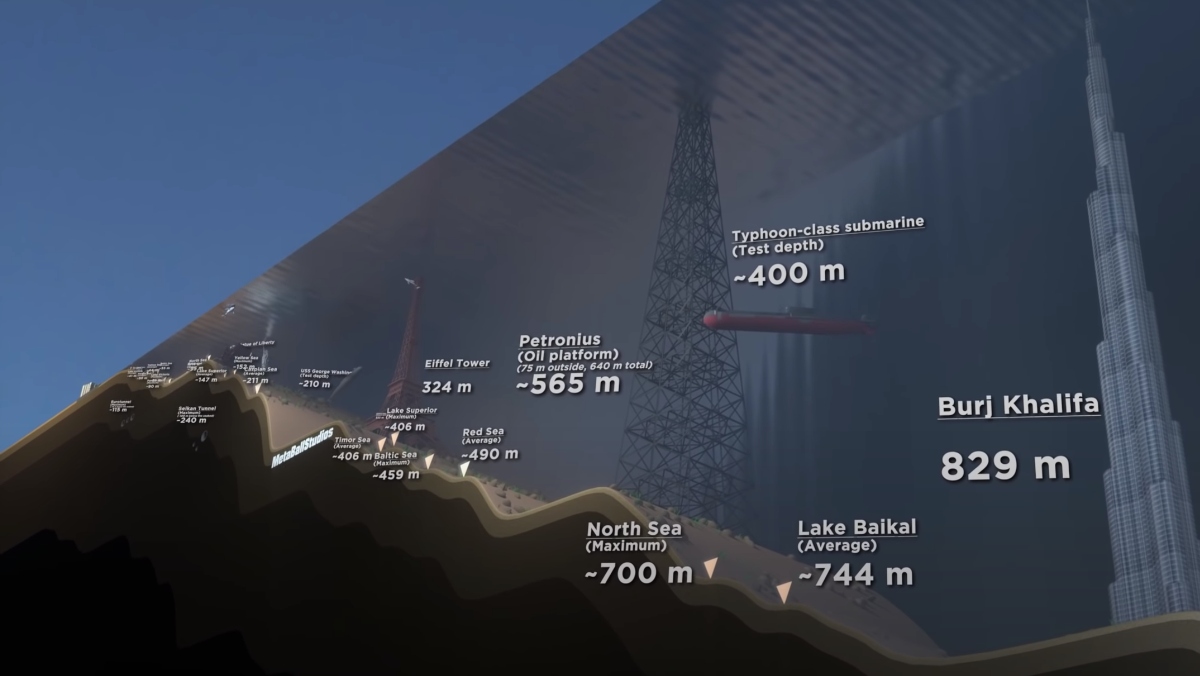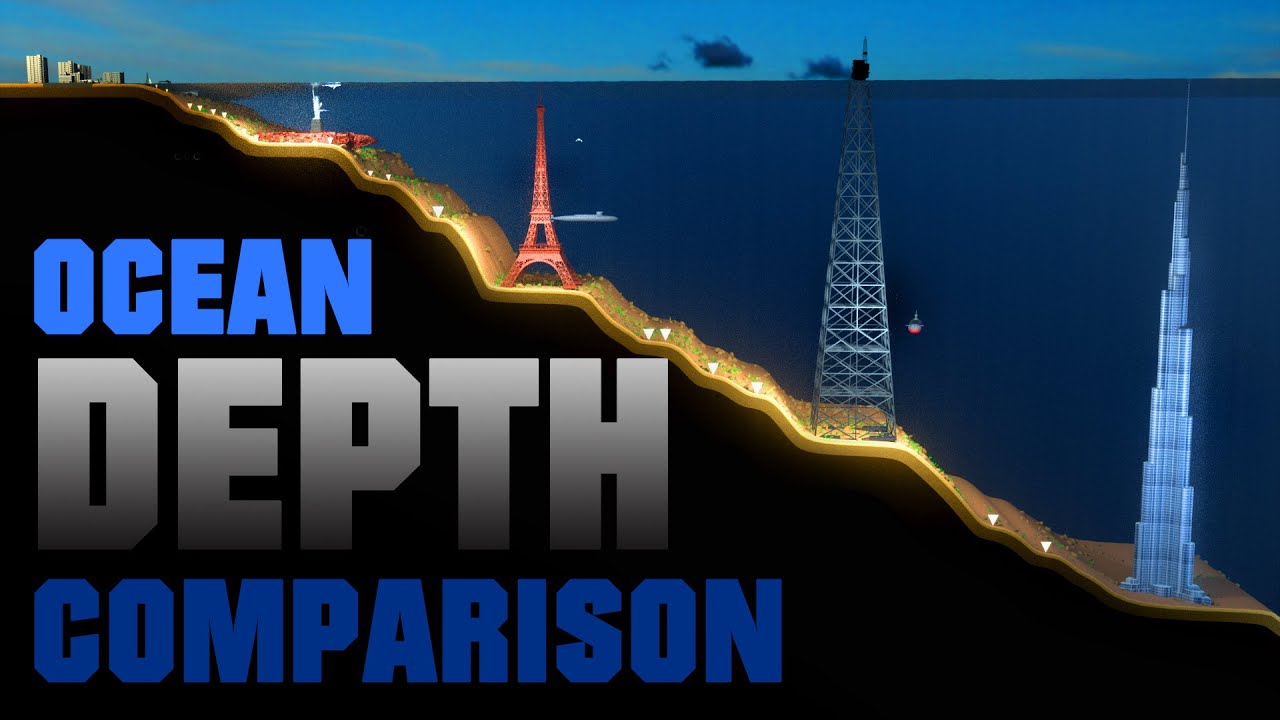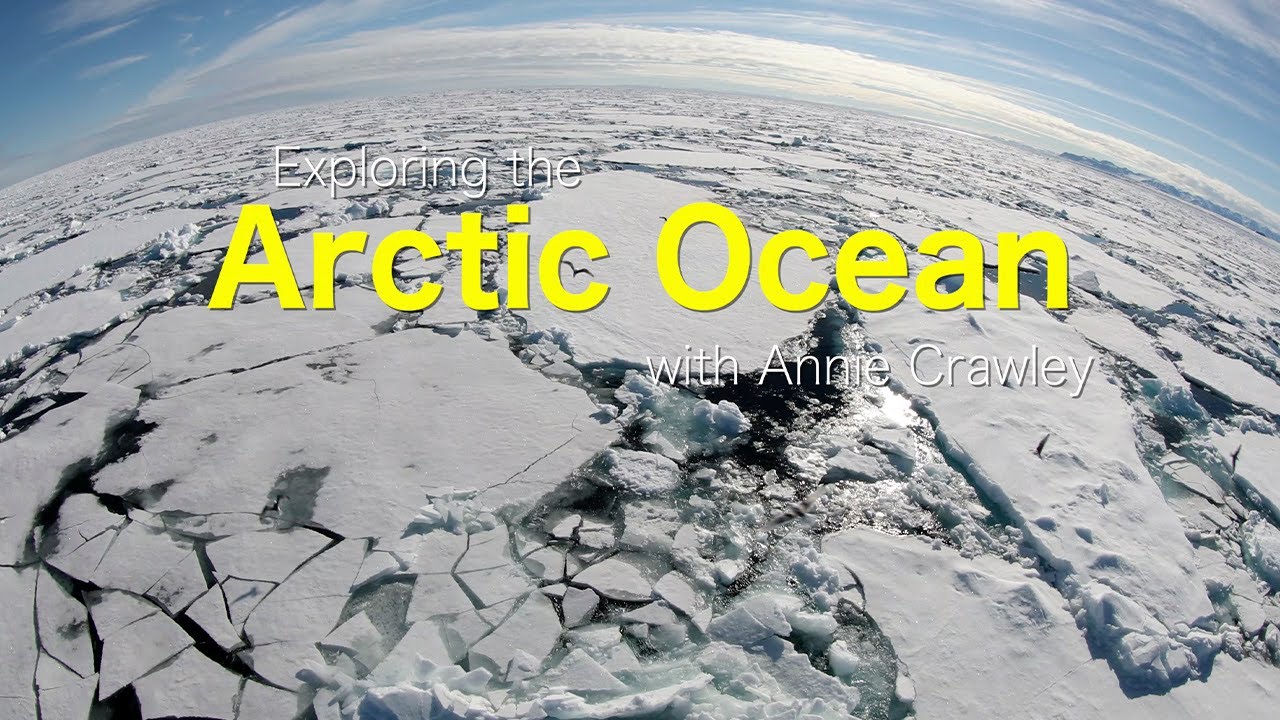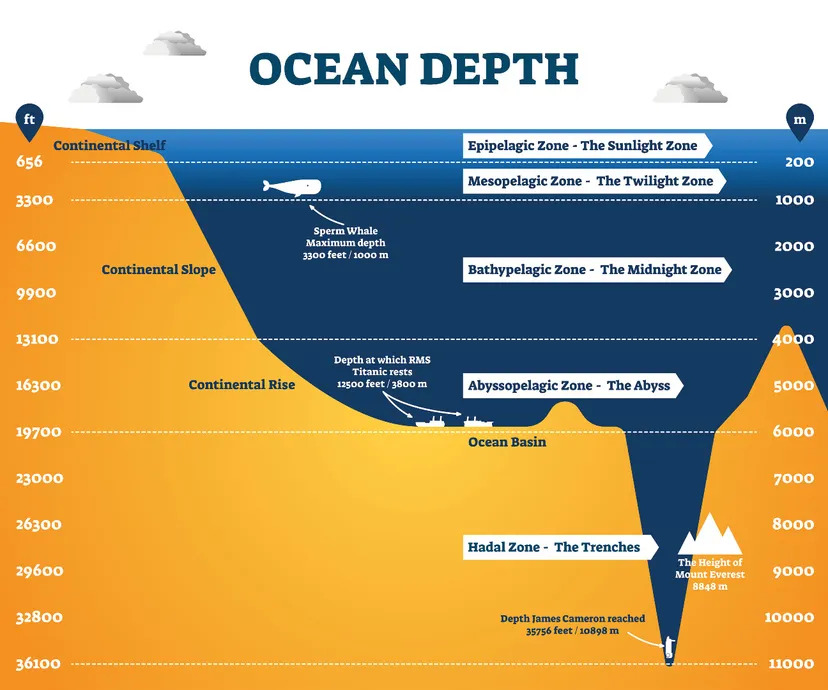Video Revealing Ocean Depths Gives People Anxiety
A video revealing ocean depths provided a captivating visualization of the astonishing depths of the ocean. This mesmerizing footage, created by MetaBallStudios, is not only awe-inspiring but has also triggered feelings of anxiety among viewers.
Author:Black Crystal Reviewer:Maxwell CanvasJun 05, 202327.5K Shares367.6K Views

A video revealing ocean depthsprovided a captivating visualization of the astonishing depths of the ocean. This mesmerizing footage, created by MetaBallStudios, is not only awe-inspiring but has also triggered feelings of anxiety among viewers.
MetaBallStudios Video Revealing Ocean Depths
The video showcases the vastness of the ocean, starting from the shallows and delving into the average and maximum depths of various oceans worldwide. It incorporates well-known landmarks for scale, such as the Eiffel Tower and Burj Khalifa.
This remarkable display offers a chilling perspective of the ocean's immense magnitude, leaving viewers in awe and discomfort.

Ocean DEPTH Comparison 🌊 (3D Animation)
The sheer expanse of the ocean is difficult to comprehend. It is so vast that even massive container ships can vanish without a trace. While numbers alone can describe its enormity, witnessing a visual representation of its depth is an entirely different experience.
MetaBallStudios' video delves into the average depths of each ocean and sea, revealing fascinating facts and landmarks along the way.
The video captures various significant depths within the ocean. For instance, it features Ahmed Gabr's record-breaking scuba dive, reaching a staggering 332 meters below the surface.
Additionally, it showcases SAPEI, the deepest submarine cable, extending approximately 1600 meters into the abyss. As the footage progresses, viewers are presented with average depth statistics, including the Atlantic Ocean's 3646-meter depth, where the wreckage of the Titanic rests, lying 3700 meters beneath the surface.
The video also presents an intriguing comparison between Mount Everest and the ocean's deepest point. It reveals the point at which the towering Mount Everest would be completely submerged by the ocean, emphasizing the vastness of the ocean's depths.
Finally, the video culminates in the Mariana Trench, located in the Pacific Ocean south of Japan, which houses the deepest point known as Challenger Deep. This abyss plunges to a mind-boggling 11,000 meters below the surface, making the peak of Mount Everest appear diminutive in comparison.
Beyond its sheer scale, the deep ocean harbors countless mysteries and oddities. Hydrothermal vents, which emit water infused with chemicals at scorching temperatures, sustain life forms that are independent of the sun's energy.
Some even speculate that chemical soups from these deep-sea vents might have played a role in the origins of life on Earth. Exploring the deep ocean is akin to venturing into an alien world, as it remains largely uncharted and full of surprises.
Overall, the captivating video from MetaBallStudios has provided a mesmerizing glimpse into the astonishing depths of the ocean. While the vastness and mysteries of the deep sea are awe-inspiring, they also evoke feelings of anxiety in many viewers.
The footage serves as a reminder of the enormity and untapped potential of the ocean, raising questions about our limited understanding of this vast, inhabitable space on our planet.
As we continue to explore and discoverthe secrets hidden beneath the ocean's surface, it is crucial to recognize the importance of protecting this fragile ecosystem from the threats of pollution and environmental degradation.
How Deep Is The Ocean? Exploring The Depths Of The Five Ocean Basins
For centuries, humans have been enthralled by the ocean's allure, embarking on expeditions and venturing towards the boundless horizon in search of new realms and thrilling adventures.
Today, we are aware that the ocean covers approximately 71% of the Earth's surface. Yet, despite our efforts to comprehend its vastness, the true extent of the ocean remains nearly unfathomable.
The globalocean has been divided into five main basins - the Pacific, Atlantic, Indian, Arctic, and Southern Ocean basins. These basins encompass a staggering 90% of all habitable space on Earth, making them the largest ecosystem on the planet. Additionally, they hold an astounding 97% of the world's water.
The Depths Of The Ocean
Determining the depth of the ocean is a complex task, given its immense size and varying topography. Scientists have estimated the average depth of the ocean basins to be approximately 3,682 meters (12,080 feet). However, these estimates are based on satellite measurements and are subject to refinement as we continue to explore and map the ocean floor.
Interesting Facts
- Interestingly, we have greater knowledge about the surface of the Moon and Mars than we do about the deep seafloor.
- The ocean depths are shrouded in mystery, and there is still much to learn about this vast and uncharted realm.
Exploring The Pacific Ocean Basin
The Pacific Ocean basin is not only the largest but also the deepest among the five ocean basins. Encompassing almost 30% of Earth's surface and roughly 46% of the water surface, it spans a massive area of 165,250,000 square kilometers (63,800,000 square miles).
Stretching from the Bering Strait, where it connects to the Arctic Ocean basin, to the Southern Ocean basin, the Pacific Ocean basin extends from north to south over an impressive distance of approximately 19,000 kilometers (12,000 miles). It is also connected to the Indian Ocean basin near Sumatra through the Strait of Malacca and, to the east, to the Atlantic Ocean basin via the Strait of Magellan and the Drake Passage.
The average depth of the Pacific Ocean basin is 4,280 meters (14,040 feet), and it holds the deepest known point on Earth - Challenger Deep, situated in the Mariana Trench to the east of the Philippines. Challenger Deep reaches an astonishing depth of 11,034 meters (36,201 feet). The Mariana Trench itself extends for more than 1,500 miles (2,550 kilometers) and spans a width of 43 miles (69 kilometers).
Interesting Facts
- To put the depth of Challenger Deep into perspective, Mount Everest, the highest peak on land, would still have more than a mile to spare if it were placed at the bottom of the trench.
- The Pacific Ocean basin is home to the "Ring of Fire," an area where a significant number of the world's most active volcanoes are located.
Unveiling The Secrets Of The Atlantic Ocean Basin
Following the Pacific Ocean basin, the Atlantic Ocean basin is the second-largest in terms of size. It separates the continents of Africa and Europe from the Americas and covers approximately one-fifth of Earth's surface.
The name "Atlantic" originates from the Greek mythological figure Atlas. The Atlantic Ocean basin exhibits an elongated "S" shape and is traditionally divided into the North and South Atlantic at the Equator.
The Arctic Ocean to the north and the Drake Passage to the south connect the Atlantic Ocean basin to the Pacific Ocean basin. Additionally, the Panama Canal provides a man-made connection between the Atlantic and Pacific basins.
Covering about 106,400,000 square kilometers (41,100,000 square miles) when considering its bordering seas, the Atlantic Ocean basin constitutes nearly 20% of the Earth's surface. Excluding these bordering seas, it measures approximately 81,760,000 square kilometers (31,568,000 square miles).
When considering dependent seas, the average depth of the Atlantic Ocean is estimated to be 3,338 meters (10,932 feet). Without including the dependent seas, the average depth increases slightly to 3,926 meters (12,881 feet). The Puerto Rico Trench, located within the Atlantic Ocean basin, holds the distinction of being the deepest point in this basin, reaching an astounding depth of 8,605 meters (28,232 feet).
The width of the Atlantic Ocean basin varies significantly from north to south. It spans approximately 4,830 kilometers (3,000 miles) between North America and northern Africa, while the distance between Brazil and Liberia measures around 2,848 kilometers (1,770 miles).

Atlantic Ocean - How Big is Atlantic Ocean Actually?
Interesting Facts
- The Atlantic Ocean basin is characterized by a range of underwater mountains known as the Mid-Atlantic Ridge. These geological features, which can be observed through satellite imagery, form the longest mountain range on Earth, surpassing other major ranges such as the Andes and the Himalayas.
- While the Atlantic Ocean basin is expanding at a rate of five centimeters per year due to volcanic activity along the Mid-Atlantic Ridge, the Pacific Ocean basin is estimated to be shrinking by two to three centimeters annually.
Unraveling The Mysteries Of The Indian Ocean Basin
The Indian Ocean basin stretches from the eastern coast of Africa to the island of Tasmania. Its name is derived from India, and it differs from the Atlantic and Pacific Ocean basins in that it is landlocked in the Northern Hemisphere and does not reach Arctic waters, lacking a temperate-to-cold zone.
The Indian Ocean basin meets the Atlantic Ocean basin to the west at Cape Agulhas, Africa's southernmost point. Its eastern limits are less defined but typically extend from South East Cape in Tasmania along the 147° E meridian.
The northern boundary is usually drawn from Cape Londonderry in Australia, crossing the Timor Sea to the southern shores of Java, and then continuing across the Sunda Strait to Sumatra. Another limit is marked by a line drawn across the Singapore Strait.
With a surface area of approximately 70,560,000 square kilometers (27,243,000 square miles) excluding its peripheral seas, the Indian Ocean basin accounts for almost 20% of the Earth's total surface area. It stretches over 1,000 kilometers (6,200 miles) between Western Australia and the eastern coast of Africa.
The average depth of the Indian Ocean is estimated to be 3,741 meters (12,274 feet). Most parts of the Indian Ocean basin have depths around 5,000 meters (16,404 feet), while certain areas like the Wharton Basin reach depths of 6,000 meters (19,685 feet). Notably, the Arabian Sea has a depth of approximately 3,000 meters (9,842 feet), while the Bay of Bengal reaches a depth of around 2,000 meters (6,561 feet) near the southern coast of Sri Lanka.
The Java Trench, also known as the Sunda Trench, is situated off the southern coast of Java, Indonesia, and plummets to a depth of 7,450 meters (24,442 feet).
Interesting Facts
- The Indian Ocean basin hosts numerous tectonic plate boundaries, including the Rodrigues Triple Point, where the African, Indo-Australian, and Antarctic continental plates converge.
- The Indian Ocean basin experiences low oxygen levels due to a higher evaporation rate compared to run-off or precipitation influx. This unique characteristic contributes to the distinct biodiversity found in this ocean basin.
- Rivers like the Ganges and Brahmaputra, two of the largest rivers globally, contribute approximately 6,000 kilometers of runoff to the Indian Ocean basin. The proximity to the equator leads to significantly high evaporation rates in this region.
Understanding The Arctic Ocean Basin
The Arctic Ocean basin, the smallest among the five ocean basins, encompasses an area of 14,056,000 square kilometers (5,427,000 square miles). It is characterized by its extreme coldness and shallow depths.
Situated predominantly north of the Arctic Circle, the Arctic Ocean basin serves as a connection between Europe, Asia, and North America. While some water enters from the Pacific through the Bering Strait, the Norwegian Current from the Atlantic constitutes the primary source of water for this basin.
Historically, the Arctic Ocean basin was covered in year-round ice. However, due to global warming, the extent of ice coverage has significantly reduced. This phenomenon leads to fluctuations in salinity and subfreezing temperatures, impacting global climate patterns. Marine life in the Arctic Ocean basin is believed to be limited, except in its southernmost seas.
The deepest point discovered in Arctic waters reaches a depth of 5,502 meters (18,050 feet), while the average depth is relatively shallow at 987 meters (3,240 feet).

Explore the Arctic Ocean with Annie Crawley Planet Ocean Book
Interesting Facts
- The Arctic Ocean basin has the lowest salinity level among the five ocean basins due to a large input of freshwater and a low evaporation rate. Surface temperatures in this region can rise above the freezing point, reaching approximately 28.8°F.
- Changes in seawater chemistry within the Arctic Ocean basin, including low salinity levels caused by ice melting, have the potential to impact global ocean currents and subsequently influence climate patterns worldwide.
Exploring The Wonders Of The Southern Ocean Basin
The Southern Ocean basin, recognized as the fourth-largest ocean basin, encompasses approximately one-sixteenth of the total ocean area. It was officially acknowledged and accepted as a distinct ocean by the International Hydrographic Organization in 2000. Encircling Antarctica, this basin incorporates parts of the Atlantic, Indian, and Pacific Ocean basins that surround the continent.
The Southern Ocean basin features the Drake Passage, a narrow stretch of water spanning around 1,000 kilometers (600 miles) between South America and the tip of the Antarctic Peninsula.
With a surface area of 21,960,000 square kilometers (8,479,000 square miles) and a volume of 71,800,000 cubic kilometers (17,226,000 cubic miles), the Southern Ocean basin is primarily composed of deep waters. It boasts an average depth of 3,270 meters and reaches its deepest point at 7,433.6 meters (24,388 feet) in the Factorian Deep.
Interesting Facts
- Antarctica and the Southern Ocean basin house around 90% of the Earth's ice.
- The deepest point within the Southern Ocean basin, Factorian Deep, is classified as a subzero Hadal zone, making it the only such zone in the world.
People Also Ask
What Are The Major Threats To The Ocean's Depths?
Major threats to the ocean's depths include pollution, overfishing, habitat destruction, and climate change.
Are There Any Undiscovered Species In The Ocean Depths?
Yes, there are numerous undiscovered species in the ocean depths, with the majority of marine species yet to be discovered.
How Do Ocean Currents Influence The Depths Of The Ocean?
Ocean currents play a vital role in shaping the depths of the ocean, influencing nutrient distribution, marine organism movement, and sediment transport.
Conclusion
In conclusion, the awe-inspiring video revealing ocean depths serves as a powerful reminder of the vastness and mysteries that lie beneath the surface. From the majestic Pacific Ocean with its mesmerizing Mariana Trench to the expansive Atlantic, Indian, Arctic, and Southern Ocean basins, each holding its own wonders, the ocean's depths captivate our imagination.
It is a realm that continues to be explored and studied, reminding us of the immense beauty and importance of our planet's vast underwater ecosystems.

Black Crystal
Author
Black Crystal is a captivating writer who finds inspiration in the quiet corners of the street and the mysterious depths beneath bridges. With a penchant for the night, she crafts enchanting tales that explore the uncharted realms of the human experience. Embracing the darkness as her muse, Black Crystal's evocative prose and haunting imagery transport readers into a world where secrets whisper and dreams take shape.
Her writing defies categorization, inviting readers to uncover the magic hidden within the shadows and embrace the enigmatic beauty of her nocturnal narratives. Step into her realm, where the written word dances with ethereal grace, and immerse yourself in the captivating stories she weaves.

Maxwell Canvas
Reviewer
Maxwell Canvas, a charismatic and fearless crypto evangelist, defies conventions and blazes a trail in the realm of digital currencies. With his unique physique serving as a symbol of resilience, he challenges societal norms and proves that true expertise transcends appearances. Against a backdrop of a blurred and ever-shifting market, Maxwell's work becomes a masterpiece, painting a vivid picture of knowledge and inspiration.
With unwavering passion, Maxwell empowers others to embrace the transformative potential of blockchain technology. His captivating presence and unyielding dedication captivate audiences, turning skepticism into curiosity and igniting a spark of interest in the world of cryptocurrencies. Maxwell Canvas stands as a visionary force, leaving an indelible mark on the crypto landscape, inspiring others to explore decentralized possibilities and embrace a future of innovation and financial empowerment.
Latest Articles
Popular Articles
